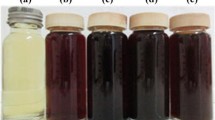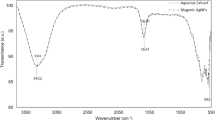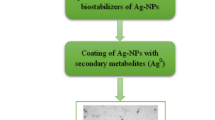Abstract
Biogenic silver nanoparticles (AgNPs) are of significant interest due to their widespread application. In order to make nontoxic cost-effective AgNPs, several microorganisms have been utilized. In the present study, emphasis was given to Anabaena variabilis–mediated AgNPs synthesis. Optimal conditions for extract preparation were heating of extraction mixture at 100 °C for 5 min, while for AgNPs synthesis, optimal conditions were 1:9 v/v (cell extract: AgNO3 (1 mM)), pH 7.4, and 30 °C reaction temperatures. The synthesized AgNPs were characterized initially by UV-Vis spectrophotometer and the maximum absorbance peak was obtained at 440 nm. XRD technique confirmed their crystalline nature. SEM with EDX showed 66% elemental silver by weight, which signified the purity of AgNPs. DLS study showed nearly monodispersed nature of AgNPs. TEM observation confirmed the synthesis of 11–15 nm spherical NPs. FTIR analysis of synthesized AgNPs showed the functional moieties responsible for their bioactivity. The biomolecules of AgNPs were confirmed by LCMS/MS. Anabaena variabilis–mediated AgNPs showed good antibacterial and antifungal activity. In combination with standard antibiotic (streptomycin) and antifungal agents (amphotericin B, fluconazole), AgNPs showed significant synergistic effect. The blend of antibacterial and antifungal properties, coupled with their intrinsic “green” and facile synthesis, made these biogenic nanoparticles attractive in nanomedicine.










Similar content being viewed by others
References
Ali K, Ahmed B, Dwivedi S, Saquib Q, Al-Khedhairy AA, Musarrat J (2015) Microwave accelerated green synthesis of stable silver nanoparticles with Eucalyptus globulus leaf extract and their antibacterial and antibiofilm activity on clinical isolates. PLoS One 10:e0131178
Aziz N, Faraz M, Pandey R, Shakir M, Fatma T, Varma A, Barman I, Prasad R (2015) Facile algae-derived route to biogenic silver nanoparticles: synthesis, antibacterial, and photocatalytic properties. Langmuir 31:11605–11612
Aziz N, Pandey R, Barman I, Prasad R (2016) Leveraging the attributes of Mucor hiemalis-derived silver nanoparticles for a synergistic broad-spectrum antimicrobial platform. Front Microbiol 7:1984
Bhaumik J, Thakur NS, Aili PK, Ghanghoriya A, Mittal AK, Banerjee UC (2015) Bioinspired nanotheranostic agents: synthesis, surface functionalization, and antioxidant potential. ACS Biomater Sci Eng 1:382–392
Chokshi K, Pancha I, Ghosh T, Paliwal C, Maurya R, Ghosh A, Mishra S (2016) Green synthesis, characterization and antioxidant potential of silver nanoparticles biosynthesized from de-oiled biomass of thermotolerant oleaginous microalgae: Acutodesmus dimorphus. RSC Adv 6:72269–72274
Clarke SP, Sc B (2013) Development of hierarchical magnetic nanocomposite materials for biomedical applications. PhD thesis, Dublin City University
Cumberland SA, Lead JR (2009) Particle size distributions of silver nanoparticles at environmentally relevant conditions. J Chromatogr A 1216:9099–9105
Danaei M, Dehghankhold M, Ataei S, Hasanzadeh Davarani F, Javanmard R, Dokhani A, Khorasani S, Mozafari MR (2018) Impact of particle size and polydispersity index on the clinical applications of lipidic nanocarrier systems. Pharmaceutics 10:2–57
Du H, Lo TM, Sitompul J, Chang MW (2012) Systems-level analysis of Escherichia coli response to silver nanoparticles: the roles of anaerobic respiration in microbial resistance. Biochem Biophys Res Commun 424:657–662
El-Naggar NEA, Hussein MH, El-Sawah AA (2018) Phycobiliprotein-mediated synthesis of biogenic silver nanoparticles, characterization, in vitro and in vivo assessment of anticancer activities. Sci Rep 8:8925
Elumalai EK, Prasad TN, Hemachandran J, Therasa SV, Thirumalai T, David E (2010) Extracellular synthesis of silver nanoparticles using leaves of Euphorbia hirta and their antibacterial activities. J Pharm Sci Res 2:549–554
Fayaz AM, Balaji K, Girilal M, Yadav R, Kalaichelvan PT, Venketesan R (2010) Biogenic synthesis of silver nanoparticles and their synergistic effect with antibiotics: a study against gram-positive and gram-negative bacteria. Nanomed Nanotechnol Biol Med 6:103–109
Feng QL, Wu J, Chen GQ, Cui FZ, Kim TN, Kim JO (2000) A mechanistic study of the antibacterial effect of silver ions on Escherichia coli and Staphylococcus aureus. J Biomed Mater Res 52:662–668
Huang L, Dai T, Xuan Y, Tegos GP, Hamblin MR (2011) Synergistic combination of chitosan acetate with nanoparticle silver as a topical antimicrobial: efficacy against bacterial burn infections. Antimicrob Agents Chemother 55:3432–3438
Husain S, Sardar M, Fatma T (2015) Screening of cyanobacterial extracts for synthesis of silver nanoparticles. World J Microbiol Biotechnol 31:1279–1283
Hwang IS, Hwang JH, Choi H, Kim KJ, Lee DG (2012) Synergistic effects between silver nanoparticles and antibiotics and the mechanisms involved. J Med Microbiol 61:1719–1726
Ingale AG, Chaudhari AN (2013) Biogenic synthesis of nanoparticles and potential applications: an eco-friendly approach. J Nanomed Nanotechnol 4:7–4165
Korshed P, Li L, Liu Z, Wang T (2016) The molecular mechanisms of the antibacterial effect of picosecond laser generated silver nanoparticles and their toxicity to human cells. PLoS One 11:e0160078
Krishnaraj C, Ramachandran R, Mohan K, Kalaichelvan PT (2012) Optimization for rapid synthesis of silver nanoparticles and its effect on phytopathogenic fungi. Spectrochim Acta A 93:95–99
Kumar A, Pandey AK, Singh SS, Shanker R, Dhawan A (2011) A flow cytometric method to assess nanoparticle uptake in bacteria. Cytom A 79:707–712
Lengke MF, Fleet ME, Southam G (2007) Biosynthesis of Silver Nanoparticles by Filamentous Cyanobacteria from a Silver(I) Nitrate Complex. Langmuir 23(5):2694–2699
Marques MB, Brookings ES, Moser SA, Sonke PB, Waites KB (1997) Comparative in vitro antimicrobial susceptibilities of nosocomial isolates of Acinetobacter baumannii and synergistic activities of nine antimicrobial combinations. Antimicrob Agents Chemother 41:881–885
Mata R, Nakkala JR, Sadras SR (2015) Biogenic silver nanoparticles from Abutilon indicum: their antioxidant, antibacterial and cytotoxic effects in vitro. Colloids Surfaces B 128:276–286
Mittal AK, Bhaumik J, Kumar S, Banerjee UC (2014) Biosynthesis of silver nanoparticles: elucidation of prospective mechanism and therapeutic potential. J Colloid Interface Sci 128:276–286
Modak SM, Fox CL (1973) Binding of silver sulfadiazine to the cellular components of Pseudomonas aeruginosa. Biochem Pharmacol 22:2391–2404
Muniyappan N, Nagarajan NS (2014) Green synthesis of silver nanoparticles with Dalbergia spinosa leaves and their applications in biological and catalytic activities. Process Biochem 49:1054–1061
Murray CK (2007) Infections in burns. J Trauma Acute Care Surg 62:S73–S62
Niraimathi KL, Sudha V, Lavanya R, Brindha P (2013) Biosynthesis of silver nanoparticles using Alternanthera sessilis (Linn.) extract and their antimicrobial, antioxidant activities. Colloids Surfaces B 102:288–291
Nisar P, Ali N, Rahman L, Ali M, Shinwari ZK (2019) Antimicrobial activities of biologically synthesized metal nanoparticles: an insight into the mechanism of action. J Biol Inorg Chem 24:929–941
Pal S, Tak YK, Song JM (2007) Does the antibacterial activity of silver nanoparticles depend on the shape of the nanoparticle? A study of the Gram-negative bacterium Escherichia coli. Appl Environ Microbiol 73:1712–1720
Qing Y, Cheng L, Li R, Liu G, Zhang Y, Tang X, Wang J, Liu H, Qin Y (2018) Potential antibacterial mechanism of silver nanoparticles and the optimization of orthopedic implants by advanced modification technologies. Int J Nanomedicine 13:3311–3327
Quinteros MA, Aristizábal VC, Dalmasso PR, Paraje MG, Páez PL (2016) Oxidative stress generation of silver nanoparticles in three bacterial genera and its relationship with the antimicrobial activity. Toxicol in Vitro 36:216–223
Ramalingam B, Parandhaman T, Das SK (2016) Antibacterial effects of biosynthesized silver nanoparticles on surface ultrastructure and nanomechanical properties of Gram-negative bacteria viz. Escherichia coli and Pseudomonas aeruginosa. ACS Appl Mater Interfaces 8:4963–4976
Re R, Pellegrini N, Proteggente A, Pannala A, Yang M, Rice-Evans C (1999) Antioxidant activity applying an improved ABTS radical cation decolorization assay. Free Radic Biol Med 26:1231–1237
Rhim JW, Hong SI, Park HM, Ng PKW (2006) Preparation and characterization of chitosan-based nanocomposite films with antimicrobial activity. J Agric Food Chem 54:5814–5822
Saravanan M, Barik SK, MubarakAli D, Prakash P, Pugazhendhi A (2018) Synthesis of silver nanoparticles from Bacillus brevis (NCIM 2533) and their antibacterial activity against pathogenic bacteria. Microb Pathog 116:221–226
Sharma VK, Yngard RA, Lin Y (2009) Silver nanoparticles: green synthesis and their antimicrobial activities. Adv Colloid Interf Sci 145:83–96
Singh G, Babele PK, Shahi SK, Sinha RP, Tyagi MB, Kumar A (2014) Green synthesis of silver nanoparticles using cell extracts of Anabaena doliolum and screening of its antibacterial and antitumor activity. J Microbiol Biotechnol 24:1354–1367
Siritongsuk P, Hongsing N, Thammawithan S, Daduang S, Klaynongsruang S, Tuanyok A, Patramanon R (2016) Two-phase bactericidal mechanism of silver nanoparticles against Burkholderia pseudomallei. PLoS One 11:e0168098
Smirnoff N, Cumbes QJ (1989) Hydroxyl radical scavenging activity of compatible solutes. Phytochemistry 28:1057–1060
Stanier RY, Kunisawa R, Mandel M, Cohen-Bazire G (1971) Purification and properties of unicellular blue-green algae (order Chroococcales). Bacteriol Rev 35:2–171
Su HL, Chou CC, Hung DJ, Lin SH, Pao IC, Lin JH, Huang FL, Dong RX, Lin JJ (2009) The disruption of bacterial membrane integrity through ROS generation induced by nanohybrids of silver and clay. Biomaterials 30:5979–5987
Sudha SS, Rajamanickam K, Rengaramanujam J (2013) Microalgae mediated synthesis of silver nanoparticles and their antibacterial activity against pathogenic bacteria. Indian J Exp Biol 51:393–399
Suganya KU, Govindaraju K, Kumar VG, Dhas TS, Karthick V, Singaravelu G, Elanchezhiyan M (2015) Size controlled biogenic silver nanoparticles as antibacterial agent against isolates from HIV infected patients. Spectrochim Acta A 144:266–272
Tian J, Wong KK, Ho CM, Lok CN, Yu WY, Che CM, Chiu JF, Tam PK (2007) Topical delivery of silver nanoparticles promotes wound healing. Chem Med Chem 2:129–136
Tripathi DK, Singh S, Singh S, Pandey R, Singh VP, Sharma NC, Prasad SM, Dubey NK, Chauhan DK (2017) An overview on manufactured nanoparticles in plants: uptake, translocation, accumulation and phytotoxicity. Plant Physiol Biochem 110:2–12
Venkatesan J, Kim SK, Shim MS (2016) Antimicrobial, antioxidant, and anticancer activities of biosynthesized silver nanoparticles using marine algae Ecklonia cava. Nanomaterials 6:12–235
Wayne P (2008) Clinical and laboratory standards institute: reference method for broth dilution antifungal susceptibility testing of yeasts; approved standard. CLSI document M27-A3 and supplement S, 3, pp 6-12
Wikler MA, Cockerill FR, Craig WA, Dudley MN, Eliopoulos GM, Hecht DW, Hindler JF, Low DE, Sheehan DJ, Tenover FC, Turnidge JD (2007) Performance standards for antimicrobial susceptibility testing; seventeenth informational supplement. Clinical and Laboratory Standards Institute (CLSI).
Wypij M, Czarnecka J, Świecimska M, Dahm H, Rai M, Golinska P (2018) Synthesis, characterization and evaluation of antimicrobial and cytotoxic activities of biogenic silver nanoparticles synthesized from Streptomyces xinghaiensis OF1 strain. World J Microbiol Biotechnol 34:2–23
Acknowledgments
The authors gratefully acknowledge the Indian Council of Medical Research (ICMR) and Defence Research and Development Organisation (DRDO), Government of India, for the financial assistance to carry out this research work. The authors are grateful to the Centre for Nanoscience and Nanotechnology (CNN) Jamia Millia Islamia for analytical facility.
Funding
DRDO research grant was utilized for completing the objectives of the work.
Author information
Authors and Affiliations
Contributions
Tasneem Fatma conceived and designed the experiments; Irshad Ahamad, Md. Nafe Aziz, and Almaz Zaki performed the experiments; Irshad Ahamad, Md. Nafe Aziz, and Tasneem Fatma analysed the data; Irshad Ahamad and Md. Nafe Aziz prepared the draft; Md. Nafe Aziz and Tasneem Fatma supervised for the present investigation. All authors approved the final manuscript.
Corresponding author
Ethics declarations
Conflict of interest
The authors declare that there is no conflict of interest.
Additional information
Publisher’s note
Springer Nature remains neutral with regard to jurisdictional claims in published maps and institutional affiliations.
Supplementary information
ESM 1
(PDF 657 kb)
Rights and permissions
About this article
Cite this article
Ahamad, I., Aziz, N., Zaki, A. et al. Synthesis and characterization of silver nanoparticles using Anabaena variabilis as a potential antimicrobial agent. J Appl Phycol 33, 829–841 (2021). https://doi.org/10.1007/s10811-020-02323-w
Received:
Revised:
Accepted:
Published:
Issue Date:
DOI: https://doi.org/10.1007/s10811-020-02323-w




